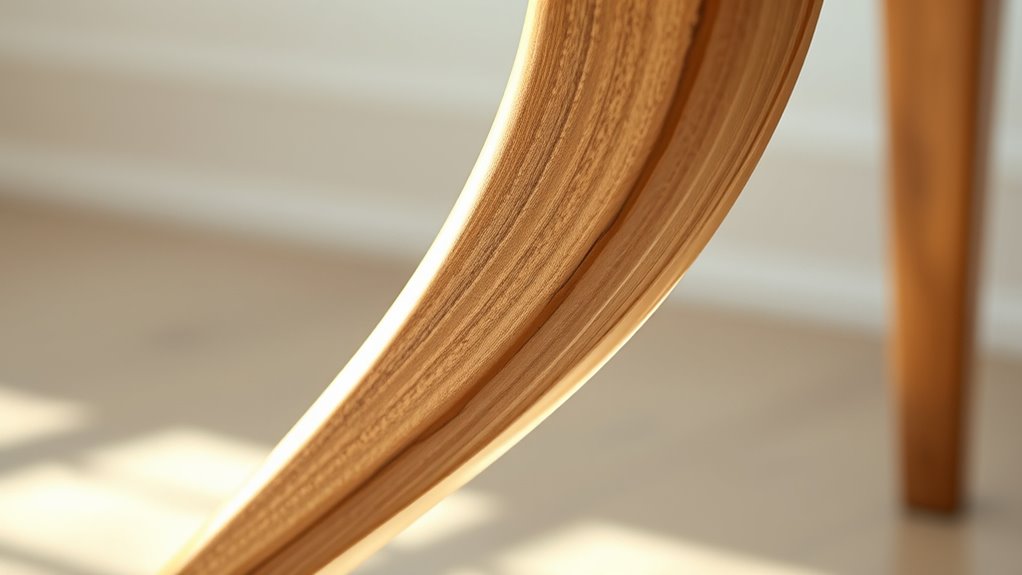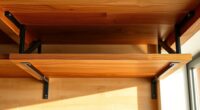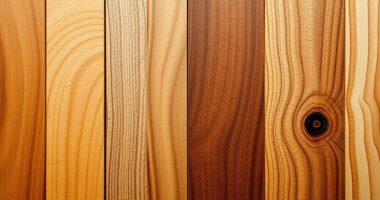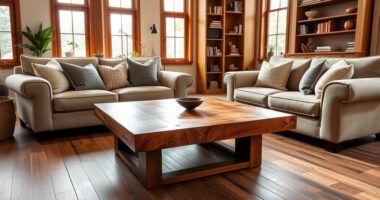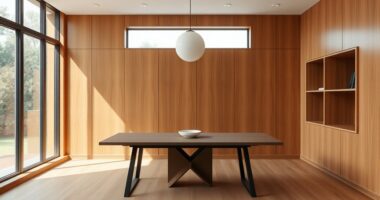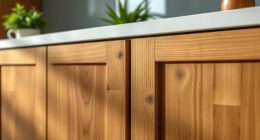The elegant shape of cabriole legs is based on simple geometric curves, primarily an elegant S-shape inspired by natural motion. You’ll notice that the curves originate from basic shapes, like circles and arcs, which create a flowing, graceful form. This design reflects both mathematical precision and artistic expression, giving furniture its timeless appeal. Keep exploring how these basic shapes combine to produce such sophisticated beauty.
Key Takeaways
- Cabriole legs are based on simple geometric principles that create graceful, flowing curves with an S-shape profile.
- The curvature originates from natural motions, such as the movement of the eye and hand, contributing to their organic appearance.
- Variations in the curvature’s tightness and tapering influence both aesthetic elegance and structural stability.
- The flowing line guides visual rhythm, balancing decorative appeal with functional support.
- Understanding the geometric foundation enhances appreciation of the craftsmanship and timeless design of cabriole legs.
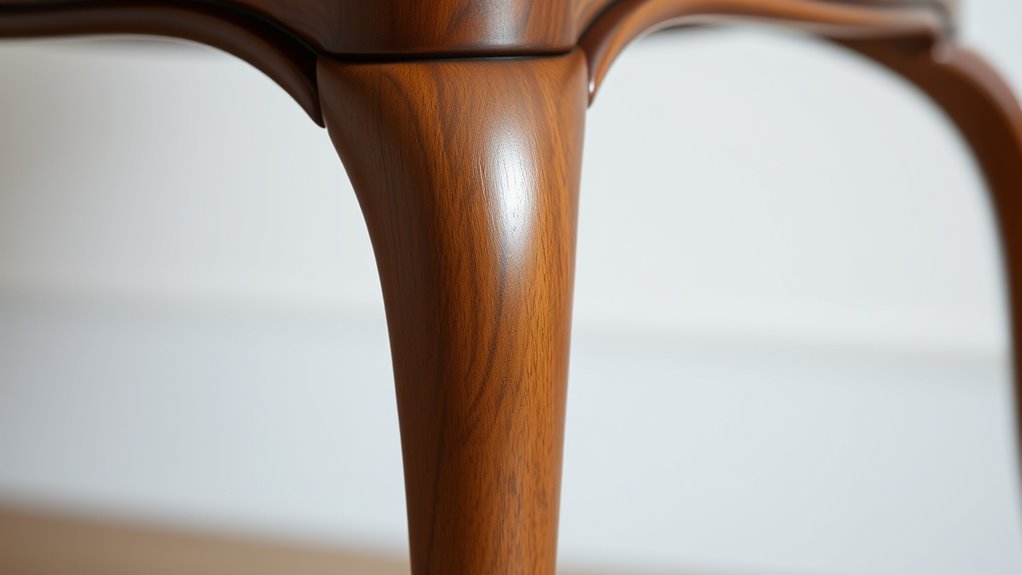
Cabriole legs are a classic furniture detail that combines elegance with simplicity, making them a popular choice in many designs. Their graceful, flowing shape instantly adds a touch of sophistication to any piece. At the core of their charm lies a fundamental understanding of simple geometry, which makes their construction both beautiful and functional. When you look closely at a cabriole leg, you’ll notice the distinct curve—an S-shaped form that originates from a specific curvature origin. This origin often traces back to 18th-century French furniture styles, where artisans experimented with flowing lines inspired by nature and organic forms. The curvature origin isn’t just a stylistic choice; it’s rooted in the natural motion of the human eye and hand, creating a sense of movement and grace that feels both natural and deliberate.
Understanding the design variations of cabriole legs reveals a fascinating spectrum of styles. Despite their common foundation, the curves can vary considerably—from tight, subtle bends to more exaggerated, sweeping arcs. Some designs feature a gentle S-curve that elongates the leg, giving a delicate, refined appearance. Others might incorporate a more dramatic curve, emphasizing a bold statement piece. The design variations also extend to the thickness and tapering of the leg, which influence the overall aesthetic and structural strength. For example, a more slender, tapered cabriole leg exudes elegance and lightness, ideal for antique or French provincial furniture. In contrast, a thicker, more robust curve might be used in traditional or Victorian styles, adding a sense of stability and grandeur.
Cabriole legs vary from delicate S-curves to bold arcs, influenced by style, strength, and visual elegance.
You’ll find that the choice of curvature and design variation isn’t just about aesthetics; it impacts how the piece feels and interacts with the space. The curvature origin guides the overall flow, affecting how the eye moves along the furniture’s form. When you select a cabriole leg with a particular curve, you’re choosing a visual rhythm that complements the design’s intent—be it delicate refinement or bold statement. The variations also influence how the leg supports weight and balances with the rest of the furniture. Knowing the subtle differences in curvature origin and design variations allows you to appreciate the craftsmanship behind each piece, whether it’s a vintage side table or an ornate bureau.
In essence, the simple geometry of cabriole legs combines mathematical precision with artistic expression. By understanding their curvature origin and exploring design variations, you can better appreciate the timeless elegance they bring to furniture design. This balance of form and function is what makes cabriole legs an enduring symbol of refined craftsmanship.
Frequently Asked Questions
How Did Cabriole Legs Originate Historically?
You might find that cabriole legs originated during the early woodworking techniques of the 18th century, influenced by historical furniture styles. These elegant, curved legs mimic natural shapes like animal limbs, reflecting craftsmanship and aesthetic appeal. As artisans refined their skills, they incorporated cabriole legs into furniture design, making pieces more stylish and functional. This design became a hallmark of furniture from that era, blending form with function seamlessly.
Are There Variations in Cabriole Leg Design Across Cultures?
Think of cabriole legs as a chameleon, adapting beautifully across cultures. You’ll notice variations shaped by cultural influences and regional styles—European designs often feature ornate carvings, while Asian versions may have sleeker, minimalist lines. These differences reflect local tastes and craftsmanship, making cabriole legs a fascinating blend of tradition and innovation worldwide. So, yes, their design isn’t one-size-fits-all but a rich tapestry of regional styles.
What Tools Are Best for Crafting Cabriole Legs?
When crafting cabriole legs, you should use sharp chisels for wood carving to shape the elegant curves precisely. Incorporate joinery techniques like mortise and tenon joints for stability and strength. A good saw, like a backsaw, helps with accurate cuts, while clamps keep everything secure during assembly. Using these tools guarantees your cabriole legs are both beautiful and durable, highlighting your craftsmanship.
How Does Wood Type Affect Cabriole Leg Shape?
Sure, because choosing the perfect wood type for cabriole legs is as easy as picking a flavor of ice cream, right? Well, think again. Your wood grain dictates the leg’s elegance and strength, while finish options highlight its natural beauty or hide flaws. Hardwoods like maple or cherry hold shape better, giving your legs that graceful curve, whereas softer woods might warp or lose their charm over time. So, pick wisely!
Can Modern Furniture Replicate Traditional Cabriole Leg Geometry?
You can definitely replicate traditional cabriole leg geometry in modern furniture through design innovation and material adaptation. By understanding the classic curves and proportions, you can create sleek, contemporary versions using new materials like metal or engineered wood. This approach allows you to honor the traditional aesthetic while embracing modern techniques, resulting in furniture that combines timeless elegance with current design trends.
Conclusion
Now that you see the secret behind those graceful cabriole legs, it’s like revealing the universe’s most elegant code. With just a few simple curves and lines, you hold the power to transform any piece into a masterpiece that could make Picasso jealous. Imagine wielding this knowledge and creating furniture so stunning, even the stars might envy your craftsmanship. So, go on—embrace the geometry and turn every project into a jaw-dropping work of art!
